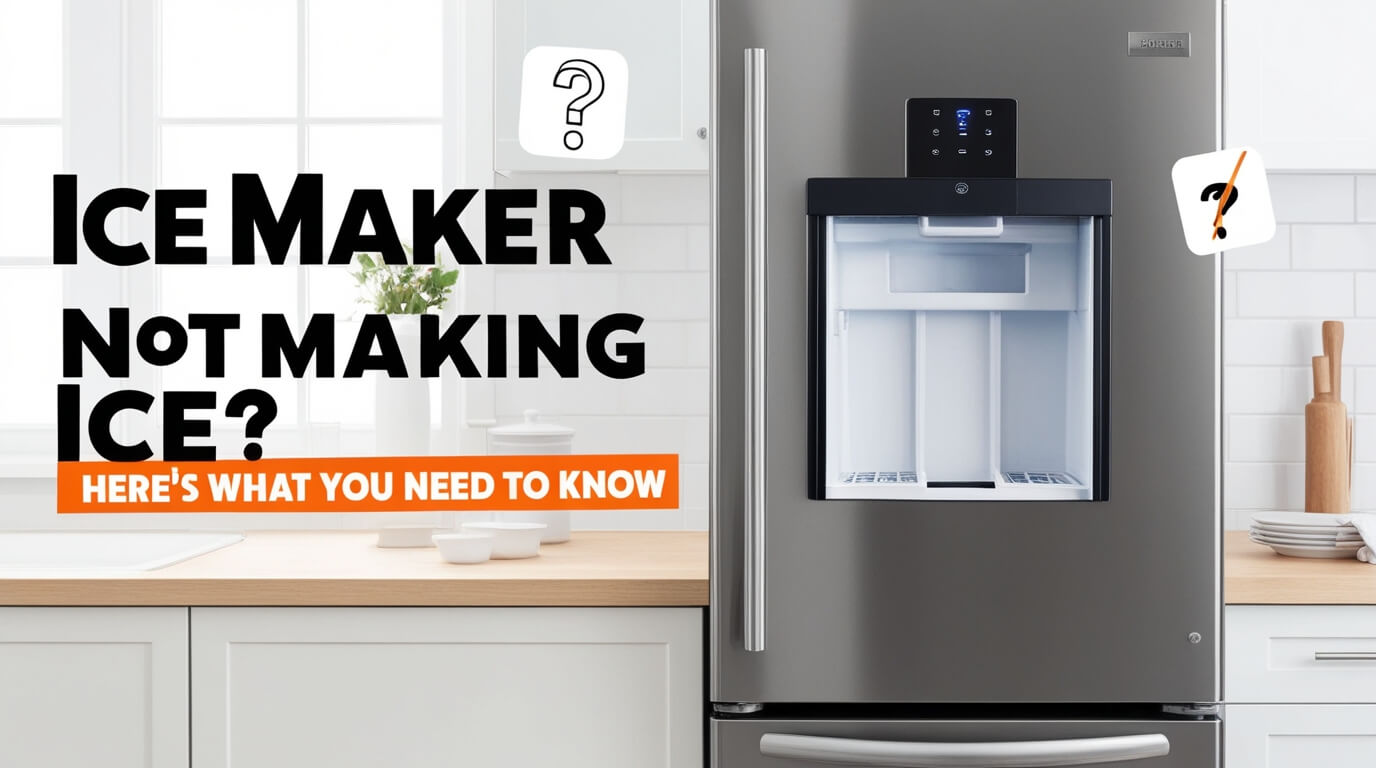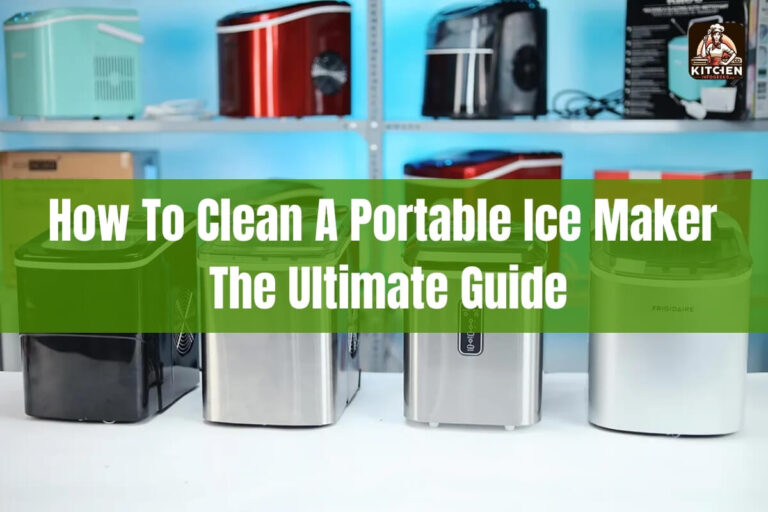
Is your ice maker letting you down when you need it most? The most common reasons for an ice maker not making ice include water supply issues, temperature problems, and mechanical malfunctions. Don’t worry – we’ve got you covered with solutions to get your ice maker back in action.
Let’s dive into the world of ice makers and uncover why yours might be on strike. We’ll explore common culprits, walk through troubleshooting steps, and even share some DIY fixes. By the end, you’ll be armed with the knowledge to tackle most ice maker issues head-on.
So, grab a (sadly, warm) drink, and let’s get your ice maker back to its frosty best!
Common Reasons Your Ice Maker Isn’t Producing Ice
When your ice maker stops working, it’s like losing a faithful friend on a hot summer day. But before you panic, let’s look at the usual suspects behind this chilly problem.
Water Supply Issues
Often, the root of ice maker woes lies in its water supply. Here’s what might be happening:
- Clogged water filter: Over time, your water filter can get stuffed with debris, slowing water flow to a trickle.
- Kinked water line: A twisted supply line can cut off water flow faster than you can say “ice, ice baby.”
- Low water pressure: If your home’s water pressure is lower than a limbo stick, your ice maker might struggle to fill up.
Temperature Problems
Sometimes, it’s all about the thermometer. Your ice maker needs just the right chill to do its job.
- Freezer too warm: If your freezer feels more like a refrigerator, ice doesn’t stand a chance.
- Freezer too cold: Surprisingly, an overly frigid freezer can also cause issues, freezing water before it reaches the ice maker.
- Thermostat malfunction: A faulty thermostat might be giving your freezer the wrong marching orders.
Mechanical Malfunctions
When the machinery itself goes haywire, your ice production grinds to a halt.
- Faulty water inlet valve: This vital part controls water flow into your ice maker. If it’s broken, no water means no ice.
- Defective ice maker assembly: Sometimes, the ice maker itself decides to retire early.
- Clogged ice chute: A blocked path can prevent ice from reaching your glass, even if the maker is working fine.
Troubleshooting Your Non-Working Ice Maker
Now that we know the potential culprits, let’s play detective and figure out what’s wrong with your particular ice maker.
Checking the Water Line
First things first, let’s make sure your ice maker isn’t dying of thirst.
- Locate the shut-off valve: Usually found under the sink or behind the fridge.
- Ensure it’s fully open: A partially closed valve can starve your ice maker of water.
- Inspect for kinks: Gently pull your fridge out and check the line for any twists or bends.
- Look for leaks: A puddle under your fridge could signal a leak in the water line.
Inspecting the Water Filter
A clogged filter can turn your ice maker into a lazy bum. Here’s how to check:
- Find your filter: Check your fridge manual for its location.
- Examine it: If it looks dirty or you can’t remember when you last changed it, it’s time for a new one.
- Replace if necessary: Follow your manual’s instructions for a quick swap.
Examining the Ice Maker Assembly
Sometimes the problem lies within the ice maker itself.
- Check the feeler arm: This metal arm should move freely up and down.
- Look for ice buildup: Excess ice can jam the works.
- Inspect the ice mold: If it’s dirty or damaged, it might not be releasing ice properly.
Step-by-Step Guide to Fix an Ice Maker That’s Not Making Ice
Ready to roll up your sleeves? Let’s tackle some common ice maker issues.
Addressing Water Supply Problems
- Replace the water filter: A fresh filter can work wonders for water flow.
- Straighten the water line: Gently untwist any kinks you find.
- Check water pressure: If it’s low throughout your home, consider calling a plumber.
Resolving Temperature-Related Issues
- Adjust freezer temperature: Aim for 0°F (-18°C) for optimal ice-making conditions.
- Clean condenser coils: Dusty coils can make your freezer work harder than necessary.
- Check door seals: A loose seal lets warm air in, making your freezer struggle.
Tackling Mechanical Failures
- Reset the ice maker: Unplug your fridge for a few minutes, then plug it back in.
- Clear the ice chute: Remove any blockages you can see.
- Defrost the water inlet tube: Use a hair dryer on low heat to melt any ice blockages.
When to Call a Professional for Your Ice Maker Issues
Sometimes, DIY just doesn’t cut it. Here’s when to wave the white flag and call in the pros.
Signs of Complex Ice Maker Problems
- Electrical issues: If you suspect wiring problems, it’s time for expert help.
- Refrigerant leaks: A hissing sound or warm fridge could indicate a coolant problem.
- Persistent problems: If you’ve tried everything and still no ice, a pro can diagnose tricky issues.
Benefits of Professional Ice Maker Repair
- Expert diagnosis: Pros can quickly pinpoint problems you might miss.
- Proper tools: They have specialized equipment for accurate repairs.
- Warranty protection: DIY repairs might void your warranty, but pro fixes usually don’t.
Maintaining Your Ice Maker to Prevent Future Issues
An ounce of prevention is worth a pound of cure, especially when it comes to ice makers.
Regular Cleaning and Sanitization
- Clean the ice bin: Empty and wash it monthly with mild soap and warm water.
- Sanitize the system: Run a sanitizing solution through the ice maker every few months.
- Wipe down the exterior: Keep the outside clean to prevent dirt from getting inside.
Proper Usage and Care Tips
- Don’t overfill the ice bin: This can strain the mechanism.
- Use it regularly: Frequent use keeps parts from freezing up.
- Keep the freezer door closed: Minimize warm air exposure to maintain temperature.
Frequently Asked Questions About Ice Makers Not Producing Ice
Still have questions? We’ve got answers!
Why is my ice maker slow in making ice?
Several factors can slow down ice production:
- High freezer temperature
- Low water pressure
- Partial clogs in the water line or filter
Try adjusting your freezer temperature and checking for any blockages in the water supply.
How often should I replace my refrigerator’s water filter?
Most manufacturers recommend changing your water filter every six months. However, if you have hard water or use your ice maker frequently, you might need to change it more often.
Can a frozen water line cause my ice maker to stop working?
Absolutely! A frozen water line can completely cut off the water supply to your ice maker. If you suspect this is the issue, try defrosting the line carefully with a hair dryer on low heat.
Conclusion: Restoring Your Ice Maker’s Functionality
There you have it – a comprehensive guide to tackling the frustrating problem of an ice maker not making ice. We’ve covered the common culprits, from water supply issues to mechanical failures, and provided step-by-step solutions to get your ice maker back on track.
Remember, regular maintenance is key to preventing future issues. Clean your ice maker regularly, replace the water filter as needed, and pay attention to any changes in ice production or quality.
Don’t let a malfunctioning ice maker leave you high and dry. With these tips and tricks, you’re well-equipped to keep your ice maker in top shape, ensuring a steady supply of ice for those hot summer days and refreshing drinks year-round.
Now, go forth and conquer your ice maker troubles. Here’s to frosty glasses and perfectly chilled beverages in your future!






